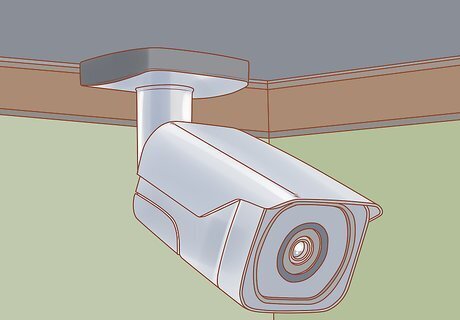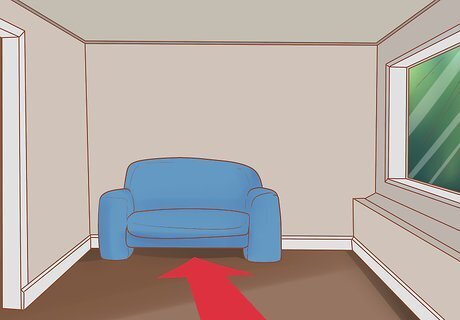
views
Searching Effectively

Start searching immediately. If you conduct an extensive search immediately, there's a good chance you'll find the cat near the last place they were seen. The more time has passed, the more likely your cat is to roam far from home. Stay calm. It is natural to feel upset, but panicking won't help you or your cat. Taking action immediately can mitigate anxiety. If you recently moved, go back to your old place and search. If you moved far from your original home, ask friends, family, and old neighbors who are still living there to search for you. Check any spaces where a cat could hide. This means inside sheds, garages, beneath decking, in bushes, up trees or on the roof.

Carry a flashlight. Even in daylight, bring a flashlight so you can look in dark places, and catch the reflection of your cat's eyes.

Call quietly for the cat. Don't assume your cat will respond to your voice as they normally do. A missing their is often a terrified cat, and may not want to leave its hiding spot even for you. Call for them in a soft, quiet voice, to avoid scaring the cat further.

Stop and listen regularly. A cat that is trapped may possibly meow. Whether you're searching by yourself or with a group, take a few minutes in every area you search to listen quietly and attentively for a meow.

Keep other animals away. Another cat in the area could have chased your cat away, especially if that cat or you have recently moved there. Ask other cat owners to keep their pets inside while you look for yours, and be prepared to increase the scope of your search as you cover the ground closest to home. If you have dogs, their enthusiasm may frighten your cat during the search. However, if your dog loves the cat and the feeling is mutual it may be useful to bring the dog on a search.

Bring along a beloved toy. If your cat has a favorite toy on a string or wand, like a stuffed mouse or feather, take it with you while you search and make it very visible, like you want the cat to play with you; this may allay fears and bring the cat out of hiding.

Recruit help from friends, neighbors or a professional lost cat finders. Warn anyone searching that if they do spot the cat, remain quiet and do not chase! It's best for the owner to approach the cat, especially since the cat it likely to be very frightened. Trade cell phone contact information with everyone involved in the search, and supply each person with a flashlight, even in daylight.

Ask for information and help from passers-by. Whenever someone walks by, ask whether he has seen your cat, showing a photograph if you have one. Postal workers, children, and other people who spend a lot of time outside in your neighborhood can be useful resources. Offering a reward increases motivation, even relatively small rewards.

Search again after nightfall. If you were searching during the day, return and repeat the steps above after it grows dark when it is more quiet. Bring a flashlight, and call softly to your cat. Lost cats are sometimes more willing to leave their hiding places at night, when they can rely on the darkness for safety.

Set up motion sensor digital cameras around your home. You may be able to catch a picture of the cat on camera so that you know they are nearby and focus your search.

Keep searching. Most cats will hide instead of run when they're lost or in a scary situation. Because of this, some cats may spend several weeks in the area, moving from one hiding place to another by night. It's not unheard-of for a lost cat to be found after a couple months.
Knowing Where to Search

Search hiding spots. When a cat becomes lost and scared, it will often run to the first hiding place it sees. Search in dense foliage, under porches, in crawlspaces, and in garages and sheds. Start near the place the cat was lost and search outward. Also check under in sewer drains, and inside pipes and vents.

Search the area five houses out by day. Many cats will hide and stay silent for a few days until they respond to your calls. Go back over the same ground near your house and have the person the cat will most likely respond to call out for them.

Look in high places. Even a declawed cat can still climb, especially when scared. Look up trees, on rooftops, and in high corners. The cat may even have crawled into the spaces between the roof and the walls, if there is an opening there.

Inspect warm places. If the weather is cold, your cat may get stuck behind a heating appliance, crawl into a heating vent, or even climb onto the engine of a car from below.

Search your neighbors' houses and yards. Knock on the doors of all homes and businesses within a few doors of the location where your cat was last seen. Ask permission to search the areas around their buildings as well, again focusing on hiding places. If there is any way for a cat to get inside those buildings, ask if the owner would be willing to search inside as well. Suggest searching for the cat yourself if they are not willing or able.

Think of places the cat could be trapped. Here are a few examples of how cats are sometimes trapped: Construction sites often contain pits, rubble, or equipment that could trap the cat. The neighbors may have locked the cat into a garage without noticing. Phone neighbors who recently left for vacation, or have another reason for not returning their car to the garage. Your cat may have jumped into a car, delivery truck, or moving truck and been driven away.

Search inside as well. Your cat could be trapped or injured underneath furniture, in a locked room or closet, or in an area you rarely visit such as an attic or basement. It could even just be hiding, especially if there are currently loud, unfamiliar noises in your house or neighborhood. Search recliner chairs, mattresses or mattress boxes, the chimney, dresser drawers, tangled drapes, behind the books in a bookcase, behind access panels, and behind appliances.
Encouraging the Cat's Return

Call outside for your cat at night. Tempt your cat out of hiding or back home by calling him/her and shaking the normal box of dry food or treats. The sound of opening a can of cat food may get a response, and if the food has a really strong scent, the cat might even respond to the smell. Lost cats are usually too wary to approach sounds, even familiar ones, but this may work in the middle of the night, when it is dark and no one is around. Pause and listen for a response after each call.

Try leaving an unwashed shirt, worn next to your skin, outside the door.

Do not leave food out. Unless you can stay up to watch all night, food left out can attract raccoons, foxes, and other cats. Leave half the food in a closed plastic container with a few holes punched in the lid. This will cause animals (hopefully your cat) to smell the food without being able to get at it, and may cause them to hang around your door longer.

Try to have someone to stay home to keep an eye out for the cat. Cats are highly territorial and are likely to come home from time to time. If everybody is out searching and there is no one home, your cat may wander off again.

Leave a baby monitor outside the back door. Keep the other end of the baby monitor by your bed, loud enough that you'll be woken up if your cat shows up and meows.

Set a humane trap. Many animal shelters will rent or lend traps that are easy to use. Feed stores even sell them. Check the trap hourly. If a wild animal is caught in it, allow it to go free and reset the trap.

Use catnip sparingly, as a frisky cat can knock a trap shut. catnip around your front door and surrounding area. This option may not be wise if your neighbors have cats as it will draw them to the area.

Empty your vacuum cleaner bag outside. This is a bad idea if coyotes or other cats come around but people advise it who think the scent will keep a cat around that place on the ground.
Spreading the Word

Distribute flyers in your neighborhood. If your cat is missing for more than a few hours, talk to your neighbors and make fliers to put under door handles. Put your name, phone number, and a photo of your cat on the flier. Describe any distinguishing marks (such as, "triangular white spot on shoulder"), and write the coat color if you're distributing black-and-white flyers. Search for online templates for "Lost Cat posters" if you're not sure how to make one from scratch. Include relevant information about specific dietary or medical conditions if life threatening. Ask neighbors to kindly check their sheds, garages and basements. Closest neighbors that the cat is reasonably familiar with are good places to check with first. Offering a reward can be good motivation and can get people out looking instead of "keeping an eye out." If you receive a report of a cat sighting that doesn't quite match your cat's description, visit the location anyway to make sure. Descriptions from strangers often don't match the description you would give the cat. Keep info on posters large, easy to read and simple. Include the relevant facts only.

Make sure that if your cat is microchipped. As well, ensure that the associated contact details are up-to-date, so a vet or animal agency can call you. Implanting a microchip is a very common procedure and only needs to be done once in a pet's life. Microchips are implanted by a veterinary professional under the skin over the shoulder blades of the cat. The microchip is about the size of a grain of rice and carries a unique code that can be read by a scanner when the hand held scanning device is waved over the pet's body. When the chip is implanted in the pet, the owner provides registration information to the microchip company that will be kept on file until the owner changes that information. The code will be linked to the owner's information through the microchip's database. When the scanner reveals the code, the microchip company can then be contacted with the code and the owner's information will be available. Most veterinarians and animal shelters will check for a microchip for no charge when a stray cat is brought in.

Place flyers in effective locations. It's best to post as many fliers as you can within a one mile radius of your home. Beyond that, there are several strategies for using your fliers effectively, and places that may be worth walking a longer distance to cover: Give fliers to veterinary offices, in case someone takes your cat there to treat injuries or begin an adoption process. Post flyers near schools and playgrounds, at children's eye level. Children are often more observant than adults, especially at noticing animals. Dog runs, dog parks, pet supply stores, and pet grooming salons are all visited by pet-friendly people who are more likely to search actively. Post on community message boards at laundromats, churches, missing pet websites, schools, pet stores, libraries, and grocery stores, or any other businesses that allows it in your neighborhood.

Post a color picture online. Many people who come across missing pets search for owners online. Think about posting a picture of your pet or searching for it on one of numerous pet recovery websites, local community sites, the local Craigslist lost pet section, and anywhere else you can think of. Include up to date contact information on all posts. Lost pet tracking websites include Missing Pet, Pets911, and TabbyTracker. FindToto for US residents costs money to use, but will broadcast a "Pet Amber Alert" to neighbors in your area. Twitter and Facebook can be used to spread the word among your network of friends. Be sure to include a photo or two. If your neighborhood association has an email news digest or web site, post a Lost Cat notice. Remember to include the cat's name, description and temperament.

Place a local newspaper notice. Pay a local newspaper to place a lost cat ad, including a description and your phone number. The more local to the area the newspaper is, the better. If no local newspaper serves your area, ask about community newsletters at a community center, a police or sheriff's station, or a local government building.

Change your voice mail message. Record a new voice mail message to make sure callers leave all relevant information. For example, say "You've reached (name). If you're calling about my lost cat, (name), please leave a message with the date and place you last saw him, along with your name and phone number. Thank you."

Call the local animal welfare agency. Usually if someone comes across a lost cat, they'll report it to the SPCA, Animal Control or your local equivalent. Call your local animal shelter and report your cat has gone missing along with all the relevant details (sex of the cat, color, and your contact information). Visit them every day or two until your cat is found, as sometimes shelters have many cats and have a difficult time matching your description to what they have. Some shelters keep a log of lost pet announcements so that they have records of your information should a similar animal come into their facility. It never hurts to make friends with the front staff at the shelter to make them personally aware of your situation and your pet's description. Home baked goods break a lot of ice anywhere you ask for help.

Find out where your "Open intake" shelter is. Check in person every couple of days. If your cat has been taken to a crowded shelter or local pound, they may only be able to hold cats for a few days before euthanizing the cat. If the staff know you're actively looking, they can be a great ally. Ask them to call you if a cat fitting your cat's description turns up.

Notify your local police department. Sometimes, police get calls about found animals, especially in areas without shelters. Officers who spend their day driving around might notice your cat. Do not call the emergency number for your police department! Call the non-emergency 311 number or just talk to your local patrol person instead. While your lost cat is an emergency to you, police need to prioritize incidents involving people.

Check "found" sections on Craigslist, newspapers and online classifieds. Check local newspapers and popular online sites daily under the "found" section. Many animal shelters have websites that show pictures of captured, stray animals, so check the website daily or more frequently. Search for "lost pets" + the name of your region to discover additional local websites.

Hire a “Cat Detective or a "Lost Cat Finder" who specializes in lost cats.” Pet detectives are available in most states trained in finding lost pets.

















Comments
0 comment